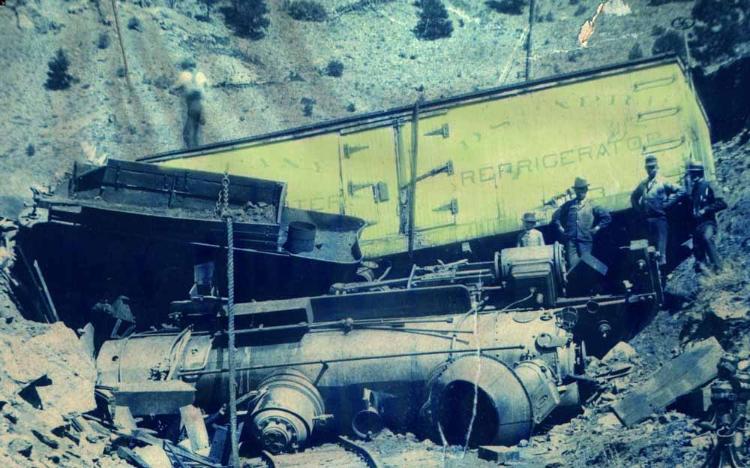Caboose roof color
12
12
|
Would the process of painting these cabeese, as well as other equipment have been done with air guns? If so, I would strongly believe that they would have sprayed the roof as well.
|
|
Mike and Tim,
Great picture! It's amazing what shows up on eBay. It's probably safe to say that the C&S cars were spray painted. This was a common practice back then and I have pictures showing AT&SF cars being sprayed in the 1930's. The compressor and paint pot were on the ground and the painter held a 6 - 8' long wand with a spray tip. This allowed them to reach up high as well as underneath the cars. To state the obvious, we have to take these pictures for what they are - a snapshot in time. For all we know, the car could have been painted pink the day, week, month, 5 years before the picture was snapped. When we assume that things were "always" a certain way, based on one picture, we get in trouble. My guess follows Mike's thinking that the roofs were originally painted the car color. Then possibly sometime later, as the roof developed leaks or whatever, it could have had a fresh layer of roofing tar or tar paper applied. Then based on variables such as availability of paint or the foreman's instructions, the roof may or may not have been repainted. The world will never know for sure. Thanks! Doug
Doug Heitkamp
Centennial, CO |
|
Non metal caboose roofs on the UP were covered with what they called Mulehide.
"Mulehide is canvas that is laid over the wooden roof, with hot asphalt brushed on to seal it. Usually, two or three coats of canvas and asphalt was used. This treatment was very waterproof, and very durable, thus the mulehide name. But, it also weathered rapidly and needed regular maintenance, which explains why metal roofs were used on freight cars. The color of mulehide would vary from new asphalt black, to highly weathered, old asphalt gray. It was never to be painted. At times, and depending on when it was last treated, the fabric pattern of the canvas is visible." - http://utahrails.net/caboose/caboose-paint.php#red Of course the UP was not the C&S and perhaps paint would have slowed down the weathering on the C&S cabooses. But assuming physics and practices were more or less the same as on the UP then we must also consider that red paint doesn't hold up so well in high country ultra violate intense exposure. Petroleum substances dry out pretty fast too. I can draw the logic that rejuvenating a tarred roof often might discourage a car shop from painting over asphalt. And the bean counters tended to break out in hives over every wasted penny so they would not be anxious to color roofs either - if that was not economical. Which practice might have proved cheaper?... who knows? This is another one of those things we don't have RR documentation to support one way or another. I'd not be surprised if thru the years the practice varied between painting roofs red and leaving them raw asphalt. Until someone finds something more definitive than a few photos (each of which represent only a split second of time out of decades of seconds ticking away) model as you will on things like this. I ain't changing my black roof 1910 cabooses based on hearsay. And neither should you. I guess we're not talking "facts" here are we? More like, "taste"....? |
|
Awesome pic, Mike, and in color, too.
Mule hide sounds like a built-up roof. Seems peculiar to me that the railroad would paint a material like asphalt: this is just asking for maintenance. Then again, if you have a sprayer out, why mask any more than you have to--save the roof walk and glass, of course.
Keith Hayes
Leadville in Sn3 |
|
You can find arguments for either position - both even. But we still don't have hard evidence to determine policy. So its another mint green reefer....
|
|
MINT GREEN REEFER!!?!
I thought that we killed that Vampire. Let it lie dead, Dead, DEad, DEAd, DEAD!!!!!!!!!!!! Blecch (holding back the bile that came into my throat) Rick |
|
Rick (lol) exactly my point for using such a scurrilous example - not only don't bring up "green reefers" - don't create any new ones either!
yyyyyYikes! |

Doug Heitkamp
Centennial, CO |
|
In reply to this post by Keith Hayes
I'd be interested to know IF the C&S used compressed air to paint these cars. Even if they did, the idea of having to "masking them off" isn't a limiter. The sides could be sprayed to within the width of the fascia board and that then hand painted to finish up - with no masking at all - for example. Our myopic perception of how things were done are ever poisoned by our retrospective point of view.
And we don't even know if they paint gunned the cars... |
|
In reply to this post by Doug Heitkamp
Ahhhh... the Green reefer! Along with the Green background and the Green loco and the green pipples and....
See? Ya just godda concentrate hard enough. |
«
Return to C&Sng Discussion Forum
|
1 view|%1 views
| Free forum by Nabble | Edit this page |

